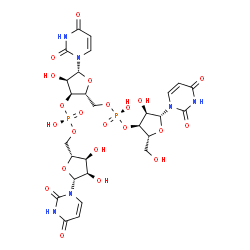Polyuridylic acid potassium salt

Polyuridylic acid potassium salt structure
|
Common Name | Polyuridylic acid potassium salt | ||
|---|---|---|---|---|
| CAS Number | 27416-86-0 | Molecular Weight | 856.533 | |
| Density | 2.0±0.1 g/cm3 | Boiling Point | N/A | |
| Molecular Formula | C18H23N4O14P(C9H11N2O8P)n | Melting Point | N/A | |
| MSDS | USA | Flash Point | N/A | |
|
Protein universe containing a PUA RNA-binding domain.
FEBS J. 281(1) , 74-87, (2014) Here, we review current knowledge about pseudouridine synthase and archaeosine transglycosylase (PUA)-domain-containing proteins to illustrate progress in this field. A methodological analysis of the literature about the topic was carried out, together with a... |
|
|
RNA Binds to Tau Fibrils and Sustains Template-Assisted Growth.
Biochemistry 54 , 4731-40, (2015) Tau fibrils are the main proteinacious components of neurofibrillary lesions in Alzheimer disease. Although RNA molecules are sequestered into these lesions, their relationship to Tau fibrils is only poorly understood. Such understanding, however, is importan... |
|
|
Polyadenylation state microarray (PASTA) analysis.
Methods Mol. Biol. 759 , 133-48, (2011) Nearly all eukaryotic mRNAs terminate in a poly(A) tail that serves important roles in mRNA utilization. In the cytoplasm, the poly(A) tail promotes both mRNA stability and translation, and these functions are frequently regulated through changes in tail leng... |
|
|
A facile and specific assay for quantifying microRNA by an optimized RT-qPCR approach.
PLoS ONE 7(10) , e46890, (2012) The spatiotemporal expression patterns of microRNAs (miRNAs) are important to the verification of their predicted function. RT-qPCR is the accepted technique for the quantification of miRNA expression; however, stem-loop RT-PCR and poly(T)-adapter assay, the ... |
|
|
Biophysical characterization of the strong stabilization of the RNA triplex poly(U)•poly(A)*poly(U) by 9-O-(ω-amino) alkyl ether berberine analogs.
PLoS ONE 7(5) , e37939, (2012) Binding of two 9-O-(ω-amino) alkyl ether berberine analogs BC1 and BC2 to the RNA triplex poly(U)(•)poly(A)(*)poly(U) was studied by various biophysical techniques.Berberine analogs bind to the RNA triplex non-cooperatively. The affinity of binding was remark... |
|
|
Polyuridylylation and processing of transcripts from multiple gene minicircles in chloroplasts of the dinoflagellate Amphidinium carterae.
Plant Mol. Biol. 79(4-5) , 347-57, (2012) Although transcription and transcript processing in the chloroplasts of plants have been extensively characterised, the RNA metabolism of other chloroplast lineages across the eukaryotes remains poorly understood. In this paper, we use RT-PCR to study transcr... |
|
|
ppGpp inhibits peptide elongation cycle of chloroplast translation system in vitro.
Plant Mol. Biol. 78(1-2) , 185-96, (2012) Chloroplasts possess common biosynthetic pathways for generating guanosine 3',5'-(bis)pyrophosphate (ppGpp) from GDP and ATP by RelA-SpoT homolog enzymes. To date, several hypothetical targets of ppGpp in chloroplasts have been suggested, but they remain larg... |
|
|
The TAL effector PthA4 interacts with nuclear factors involved in RNA-dependent processes including a HMG protein that selectively binds poly(U) RNA.
PLoS ONE 7(2) , e32305, (2012) Plant pathogenic bacteria utilize an array of effector proteins to cause disease. Among them, transcriptional activator-like (TAL) effectors are unusual in the sense that they modulate transcription in the host. Although target genes and DNA specificity of TA... |
|
|
Biophysical insights into the interaction of Ru(II) polypyridyl complexes with the RNA triplex poly(U)•poly(A)*poly(U). Intercalative ligand shape effect on third-strand stabilization.
J. Inorg. Biochem. 120 , 32-8, (2013) To explore the correlating thermodynamic factors to the structural aspects that account for the stability of the RNA triplex, two functional Ru(II) complexes containing the same ancillary ligands and different intercalative ligands, [Ru(bpy)(2)(mip)](2+) (bpy... |
|
|
The N-terminus of FILIA forms an atypical KH domain with a unique extension involved in interaction with RNA.
PLoS ONE 7(1) , e30209, (2012) FILIA is a member of the recently identified oocyte/embryo expressed gene family in eutherian mammals, which is characterized by containing an N-terminal atypical KH domain. Here we report the structure of the N-terminal fragment of FILIA (FILIA-N), which rep... |